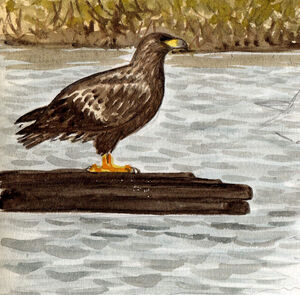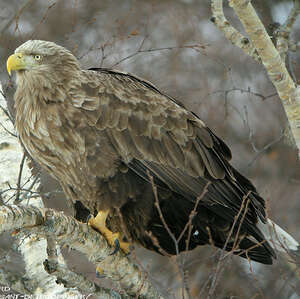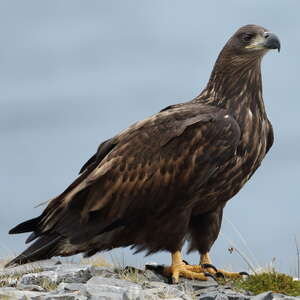White-tailed Eagle
Haliaeetus albicilla - Pygargue à queue blanche
Identification
The White-tailed Eagle is one of the 10 species of eagles present around the world. It is large in size but not the largest. The female is significantly larger than the male and can reach 90 cm in length, exceed 240 cm in wingspan and approach a weight of 6 kg; it is a very large and bulky raptor. In posture and flight, it appears quite massive. The wings are long and wide, rounded at the tips, and the tail is very short and wedge-shaped. Sexual maturity is reached late and the plumage does not become fully 'adult' until 5 or 6 years of age. The immature plumages are complex and are not discussed here.
The adult can be recognized by its entirely white tail, beige head and straw yellow beak. The upperparts are brown but appear quite light due to the beige-bordered feathers. Conversely, the lowerparts including remiges are darker brown and quite uniform. The undertail feathers are almost black, the darkest part of the body, in stark contrast to the white rectrices. In overhead flight views, the few visible black spots on the white tail are due to the undertail feathers rather than rectrices. The head is distinctive with its gigantic yellow beak. The iris is pale yellow. The tarsi, feathered on half their length, and toes, with black toenails, are yellow-lemon.
The juvenile looks very different. Its plumage is an overall dark brown upper- and underparts. The head is dark in colour. The beak is blackish and the iris is brown. The whitish lores between the beak form a pale zone. The body and coverts have beige to buff spots and streaks breaking the uniformity. The rectrices are whitish with brown fringes. The plumage will remain like this until the first moult in the 2nd year.
With age, the plumage will lighten, in particular, the head.Starting in the 4th year, the beak can take on the shape of an adult. However, the tail will only be pure white in the 8th year. The intermediate plumages are confusing and, unless you are a specialist, it can be very difficult to attribute an age to an immature. To be able to do so, refer to the images in the gallery of the species (White-tailed Eagle).
Subspecific information 2 subspecies
- Haliaeetus albicilla albicilla (Europe, n Asia to India and China)
- Haliaeetus albicilla groenlandicus (Greenland)
Foreign names
- Pygargue à queue blanche,
- Pigargo europeo,
- pigargo-eurasiático,
- Seeadler,
- rétisas,
- Zeearend,
- Aquila di mare,
- havsörn,
- Havørn,
- orliak morský,
- orel mořský,
- Havørn,
- merikotka,
- pigarg cuablanc,
- Haförn,
- bielik (zwyczajny),
- jūras ērglis,
- belorepec,
- Орлан-белохвост,
- オジロワシ,
- 白尾海雕,
- นกอินทรีหางขาว,
- 白尾海鵰,
Voice song and call
The alarm call is a powerful kiok or kouik which can be repeated. When emitted in rapid series, it inexorably resembles a Black Woodpecker's song, for example.
The song consists of the rapid repetition of wouak, wouak wouak wouak wouak... which resembles dog barking.
The begging call of the young in the nest, ouuiii ouuiii... reminds one a little of the cry of the Ural owl.
Habitat
The White-tailed Eagle is related to coastal or inland aquatic habitats. The water bodies must be large.
Behaviour character trait
The White-tailed Eagle is an extraordinarily discreet bird for its size. It can spend long periods perched on a rock by the sea or in a tree at the edge of the forest, invisible due to its cryptic plumage.
Aside from the nesting site during the breeding season, where it may be quite vocal at the time of settling, it is usually silent the rest of the time. This makes it easy to miss, even when it is known to be present. Even the young remain quiet in the nest, only calling when in the presence of one or more adults.Outside of the breeding season, the White-tailed Eagles are rather sociable and may gather around food sources without any aggression between them. Everyone can easily recall these gatherings of Steller's and White-tailed Eagles during the winter in Hokkaido, Japan, probably around feeding grounds.
Flight
The White-tailed Eagle's flight is fast and assured with powerful yet slow wing beats. The beats are shallow, and due to a rotation at the wrist, it is the hand which shows an amplitude of the beats.
When taking off from the ground, the beats become much faster to counter the weight of its body. It is capable of bursts of speed, such as when it pursues a water bird in flight, and its agility is impressive. When it captures a fish on the surface of the water, it does so with its claws after a low-gliding approach. It often glides, facilitated by the large wing surface.Dietfeeding habits
The White-tailed Eagle is both a piscivore, an ornithophage, and a necrophage, in that order of decreasing importance.
It takes dead fish on the surface, as a kite would, and in this case, it is both a piscivore and a necrophage. But it is capable of spotting and capturing living fish, such as pike, in big fish farms. Preys are captured with claws, which are extended at the last challenge.It is also a hunter of water birds, showing great agility and calculated opportunities. It is capable of following a Mallard in flight, for example. A coot is also a good option. On the coast, these are the anatinas, alcids and other larids that are targeted. The couple can hunt together to exhaust a diving bird until it can't do anymore. On the coast, the sea permanently brings edible remains, including corpses of fish and other animals that interest our raptor. On inland waters, it should not disdain the corpses of muskrat or beaver left on the banks.
Reproduction nesting
The breeding season depends on the latitude. In the southern part of its range, sexual activity can begin in January while in the Arctic, birds wait until at least April.
Usually, a couple has several territories which they can alternate. I write usually because the Lorrain couple only has one which they have occupied regularly for 10 years. On the continent, the nesting area is built at least 10 meters high on a tree, in a main fork or at the start of large branches. It is a large, or even huge, structure of branchage which can easily reach up to 150 cm in diameter and more than a meter in thickness. The gap is lined with grass, moss and lichen but not with green branches. On the coast, the nest is on a rocky shelf of the coastal cliff, less voluminous. Seaweed is placed on the litter. The female generally lays two white eggs (1 to 3) 2-4 days apart. Incubation of an egg takes an average of 38 days. So 40 days after the start of laying, the chicks have hatched. The stay in the nest, under the constant surveillance of the female in the beginning when the young are in down feathers, will last more than two months. The adults will then feed the young in turn. They will still take care of them for a while after flight until emancipation, maybe up to two more months, because in Lorraine in mid-August, adults and young are still together. In total, the season will have lasted nearly 6 months.Geographic range
The White-tailed Eagle breeds in Greenland, Iceland and across the Eurasian continent. It has even nested in the Aleutian Islands. In Northern Europe, this bird is often found along the coast. Russia has the largest population of White-tailed Eagles, although the exact numbers are unknown. Scandinavia follows next. In Western Europe, it is well-represented in the north of Germany and Poland.
It declined drastically in the 19th and early 20th centuries due to human pressure in the south of its range. But the trend turned around during the 20th century and the situation is now more positive, with the exception of South-eastern Europe, for instance the Balkans. Turkey is something of an unknown quantity. Formerly it nested in Corsica, for instance. Nowadays it is again nesting in mainland France in the Grand Est region, which is a sign of reconquest.
The most southerly breeders are in the south of the Caspian Sea and in the north-east of China.
Most European individuals are sedentary. The north-east birds are migratory, going to winter in the south of the breeding range as far as the Mediterranean, Golf Persique and the South China Sea. There are wintering grounds in the heart of Asia facilitated by large wetlands.
Threats - protection
IUCN conservation status
concern
in the Wild
threatened
evaluated
Previously considered Vulnerable due to a marked decline in the 19th and early 20th centuries, the White-tailed Eagle is no longer considered threatened as the demographic tendency has turned around and is increasing at least in the western Palearctic, except for some regions of the south around the Mediterranean and its islands. The decline was due to direct human action and the current increase is explained by protective measures. Thus, in mainland France, it has been nesting again for a decade, but its return to Corsica is probably not for tomorrow.
Sources of information
- IOC World Bird List (v15.1), Gill, F and D Donsker (Eds). 2025-12-07.
- Les rapaces diurnes et nocturnes d'Europe, M. Cuisin, P. Geroudet
- The Raptors of Europe and The Middle East, Forsman Dick
- Avibase, Lepage Denis
- Birds of the World, The Cornell Lab of Ornithology
- xeno-canto, Sharing bird sounds from around the world,
Other sources of interest
 Specification sheet created on
24/07/2023 by Jean François
Specification sheet created on
24/07/2023 by Jean FrançoisTranslation by AI Oiseaux.net
© 1996-2025 Oiseaux.net
- Accipitriformes
- Aegotheliformes
- Anseriformes
- Apodiformes
- Apterygiformes
- Bucerotiformes
- Caprimulgiformes
- Cariamiformes
- Casuariiformes
- Charadriiformes
- Ciconiiformes
- Coliiformes
- Columbiformes
- Coraciiformes
- Cuculiformes
- Eurypygiformes
- Falconiformes
- Galliformes
- Gaviiformes
- Gruiformes
- Leptosomiformes
- Mesitornithiformes
- Musophagiformes
- Nyctibiiformes
- Opisthocomiformes
- Otidiformes
- Passeriformes
- Pelecaniformes
- Phaethontiformes
- Phoenicopteriformes
- Piciformes
- Podargiformes
- Podicipediformes
- Procellariiformes
- Psittaciformes
- Pterocliformes
- Rheiformes
- Sphenisciformes
- Steatornithiformes
- Strigiformes
- Struthioniformes
- Suliformes
- Tinamiformes
- Trogoniformes


































